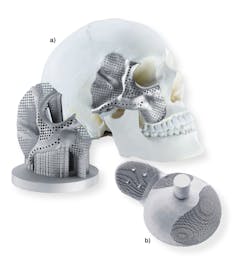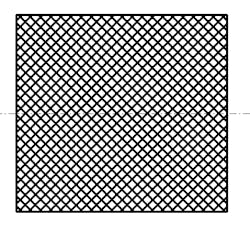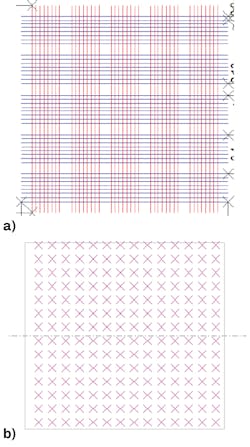During the past several decades, power beam processes such as laser technology successfully demonstrated cutting, welding, and marking capabilities. Now, surface structuring or modification can occur through electron beam and laser processing.
Titanium is a very widely used material in a variety of industry sectors, from aerospace, automotive, and consumer products. In biomedical applications, it is suitable for implants within the human body because it is a biocompatible metal that lends itself to numerous processing options, from forging, casting, machining, and additive manufacturing.
The most popular titanium alloy, Ti-6Al-4V, has long been established as the primary metallic material for orthopedic implants, as well as stents, sutures, tools, and instruments. Its derivative, Ti-6Al-4V ELI, is another popular biomedical alloy, where ELI refers to “extra low interstitials” (chemistry variation from Ti-6-4 where oxygen, iron, and carbon are kept as low as possible). An example of titanium implant components produced by 3D printing (laser additive manufacturing) is shown in Figure 1.
By using a laser to perform surface structuring of titanium, microstructures can be created that produce an increased surface area by forming unique profiles and shapes as a result of melting and rapid solidification. The profile shapes and structures encourage both hard and soft tissue growth, resulting in mechanical keying of implants to the implanted regions in the body. For instruments and tools, a grippier surface is also frequently desirable for ergonomics and handling.
How it works
Laser surface structuring of sheet metal involves using a highly focused laser beam to impinge on the surface of the metal, creating a molten pool that solidifies rapidly. Structures can be created as the beam rasters quickly through the molten pool. Titanium is a highly reactive metal, though stable in air due to the highly tenacious oxide layer that forms readily when exposed to oxygen in the air. This layer is angstroms thick and, if damaged, will repair itself almost instantly in the presence of oxygen. Titanium is sometimes used as a getter in heat treating other metallics, because its affinity for surface oxygen is incredibly high. Interestingly, this tenacious oxide layer is removable with a defocused laser beam. An annealing effect is observed as a new oxide layer is formed, with a color developed according to the thickness of the oxide layer, similar to heat tinting of titanium using furnace treatment. The creation of surface features and color change using a laser is interesting for medical applications such as tissue sticking, or using color for identification purposes or for go/no-go gages.
Trumpf performed some laser surface modification trials using a TruMark 5020 (ytterbium fiber) nanosecond laser with a 1064 nm infrared wavelength and average power of 20 W, in a TruMark station 5000. A SCANcube 10 2D galvo scanner with a 160 mm focal length f-theta lens is used for beam focusing and delivery. This optical setup creates a scan field size of 110 × 110 mm with a spot size of 67 µm. The material used was Ti-6Al-4V with sheet thickness of 1 to 3 mm. The laser beam parameters can be changed and adjusted in terms of pulse frequency and duration.
Figure 2 shows how structuring created a pyramid that increases surface area and interlocking surface structuring, which could be used for tissue bonding. Surface structures range from 1 µm (finer) to 500 µm (coarse).As mentioned, titanium easily creates a new oxide layer when the existing one is damaged or removed. Heat introduced by the laser creates an annealing process similar to heat tinting by traditional furnace methods. Color is seen as the light refracts through the thickness of the oxide layer. To produce different colors, the laser beam is slightly defocused to give a larger spot size and control the energy density deposited in the material. The resultant energy density is below the melting point of titanium. After laser processing, a new oxide layer is formed, and colors produced are temperature-resistant to 200°C.
Additional capability
Laser processing can also provide color changes to titanium surfaces from the refraction of light, based on the thickness of the tenacious oxide layer found on all titanium surfaces exposed to air. The color change depends greatly on material chemistry. But on an experimental basis, it can be used to provide permanent identification on parts and components. With further parameter optimization, other colors can be achieved that would be difficult by traditional titanium anodizing.
Although traditional anodizing of titanium and its alloys is well established, the process cannot achieve certain color values the human eye interprets as deep reds (vermillion to scarlet), deep blues, and emerald greens due to the thickness of the oxide layers formed simply skipping over these wavelengths. In Pantone colors, these are typically reds from 185–187, 192, and 199–200, and blues from 280–282, 286, 287, 288 and 294–295, 541. In greens, these could be from 315–316, 322, 323, 330, 335, 336, 564, and 662, for example, and are almost impossible to achieve with anodizing. However, with further laser parameter optimization, it might be possible to produce these and other desired colors difficult to obtain by traditional anodizing. As we look to the future, it might also be of interest to see how colors develop as a function of increasing beta alloying content (comparing CP titanium to a near-α alloy such as Ti-6242 to Ti-6-4, which is an α-β alloy, to a heavily β-stabilized alloy such as Ti-15-3-3-3).
Laser surface colorization and surface structuring also open up a whole realm of possibilities for the aerospace industry. For particularly large structural components, such as a titanium wing spar, where it is extremely difficult to dunk a huge part in an anodizing tank, the ability to colorize or texturize only a small area is attractive. Whether used to create microstructures or color changes, laser technology offers a lot of exciting potential in the processing of titanium and its alloys.


